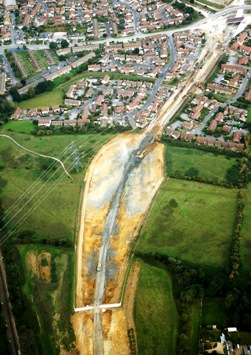
Corallian Group
The relief road cuts through a prominent east-west ridge (the Southdown Ridge), revealing an almost uninterrupted section through most of the Corallian Group. Ian West, John Wright and Kevin Page have helped interpret this section which, freshly cut by excavators, can appear quite different from the weathered coastal exposures. Sedimentary structures and other features that may be on a coastal cliff may not be immediately apparent in a machine-created pit or wall.
Although most of the Sandsfoot Formation is absent, the junction between the Corallian and overlying Kimmeridge Clay, marked by the Ringstead Waxy Clay, was briefly exposed in the excavation for a culvert north of the ridge. The Clavellata Formation, characterised by the abundance of the bivalve
Trigonia clavellata, is the most resistant of the Corallian strata at the north end of the cutting. Many fossils were found here including rare ammonites, a large nautilus and an ichthyosaur vertebra.
Beneath the Clavellata Formation lies the Osmington Oolite Formation, typically oolitic and bioclastic limestones with interbedded oolitic and pisolitic calcareous mudstones and clays. The distinct colour contrast between the white and light grey limestones and the dark grey argillaceous material makes the oolitic marker horizons relatively easy to pick out, compared to the beds of the Clavellata Formation. The ooids are usually up to about 5mm in diameter,r medium to coarse sand-size, and have a concentric structure. A well timed site visit found a horizon with many fine examples of the small echinoid,
Nucleolites scutatus, less than 2cm across and 1cm tall.
Several faults occur in the Southdown Ridge, leading to variations in dip and repetition of some beds, including the Bencliff Grit. This marks the base of the Osmington Oolite Formation and the top of the Nothe Formation. The horizon is sometimes identified by the occurrence of hard cannonball-like sandstone concretions. However, where these had not been crushed by machinery , they seemed to have taken on a more tabular form than elsewhere.
The Bencliff Grit at Southdown Ridge is most easily identified by its distinctive colour, a bright orangey or reddish brown, caused by oxidation of iron. Similar to the Bencliff Grit is the Preston Grit. The two are separated by the Nothe Clay, though little of this has been exposed along the road to date. The Preston Grit can be distinguished by the occurrence of the bivalve Gryphaea dilatata. The bivalve also characterises the underlying Oxford Clay to the south.